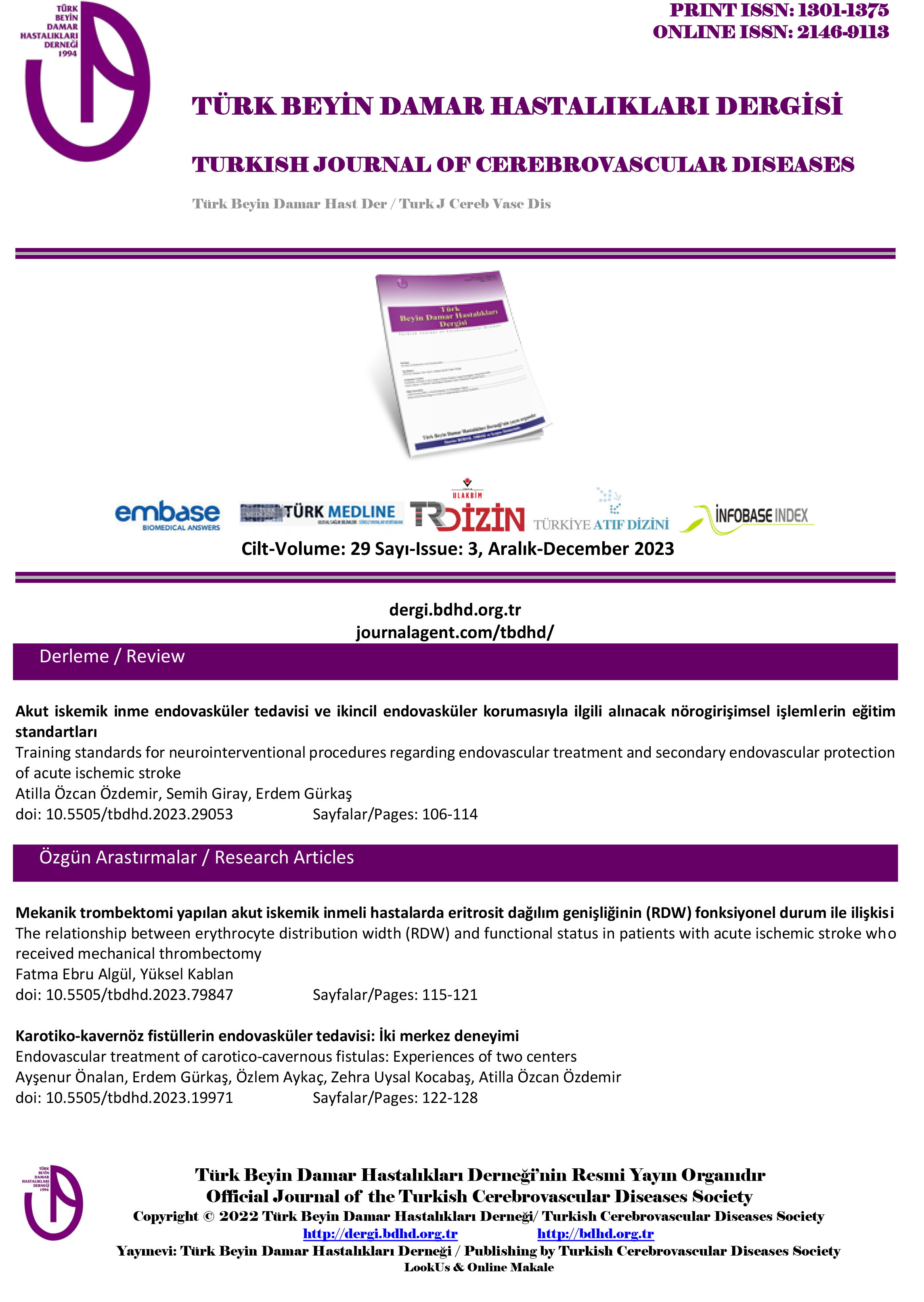Serebral Venöz Trombozlu Hastaların Değerlendirilmesi
Abdullah Yılgör, Temel Tombul, Aysel MilanlıoğluYüzüncü Yıl Üniversitesi Tıp Fakültesi, Nöroloji Ana Bilim Dalı, Van, TürkiyeAMAÇ: Bu çalışmanın amacı serebral venöz tromboz olgularındaki etyoloji, risk faktörleri, rekanalizasyon ve mortalite oranını belirlemektir.
YÖNTEMLER: Retrospektif olarak planlanan bu çalışmaya 50 hasta dahil edildi. Tüm hastalar klinik prezentasyon, etyolojik nedenler, risk faktörleri, beyin MR lezyon varlığı, tutulan anatomik lokalizasyon, rekanalizasyon ve mortalite açısından analiz edildi.
BULGULAR: Olgulardaki en sık görülen risk faktörleri protrombotik durumlar (%34 ), gebelik (%14) ve puerperyumdu (%8). En sık görülen tutulum transvers sinüs ve ikinci sıklıkta birden fazla sinüs tutulumu şeklindeydi. Klinik başvuru semptomu olarak baş ağrısı (% 68), fokal nörolojik defisiti (% 30) saptadık. Diğer taraftan, en az 3 ay sonraki hastaların rekanalizayon oranı %70.7 olarak bulundu. Eksitus olan 2 olgu dışında olgularımızın mortalitesi düşüktü. Risk faktörleri ile beyin MR lezyon varlığı veya yokluğu (p=0.42) ve takip MR anjiografideki rekanalizayon varlığı veya yokluğu arasında anlamlı ilişki bulunamadı (p=0.625).
SONUÇ: Biz, serebral venöz tromboz tanısında ve takibinde MR venografinin en iyi yöntem olduğu; erken tanı ve uygun tedavi ile rekanalizasyon oranının oldukça yüksek ve mortalitenin düşük olacağı kanısına vardık. Etyolojide trombotik durumların yanısıra gebelik ve puerperyumunda sık görülen risk faktörlerinden biri olabileceği düşünülmelidir.
Evaluation of Patients with Cerebral Venous Sinus Thrombosis
Abdullah Yılgör, Temel Tombul, Aysel MilanlıoğluYüzüncü Yıl University, Faculty Of Medicine, Neurology Department, Van, TurkeyOBJECTIVE: The aim of this article is to point out the etiology, risk factors, the rate of recanalization and mortality of cerebral venous sinus thrombosis patients.
METHODS: The current study was planned as retrospectively and fifty patients were included. All the patients were analyzed according to the clinical presentation, etiologic causes, risk factors, presence of MR lesion, the involvement of anatomic localization, recanalization and mortality.
RESULTS: The most frequent risk factors of the cases were prothrombotic conditions (34%), pregnancy (14%) and puerperium (8%). The most frequent involvement was transverse sinus and secondly more than one sinüs thrombosis. As clinical application symptoms we detected headache (68%) and then focal neurologic deficiency (30%). On the other hand, at least 3 months incidence rate of recanalization in the patients was 70.7%. Except for 2 cases that ended with death, the mortality of the cases was low. We could not find a significant association between risk factors and the presence of cerebral MR lesion or not (p=0.42) and also the presence of recanalization or not in the follow-up MR venography (p=0.625).
CONCLUSION: We have concluded that, in the diagnosis and follow-up of cerebral venous sinus thrombosis, MR venography is the best method; through early diagnosis and proper treatment, the rate of recanalization will be fairly high and mortality will be low. In etiology, besides trombotic conditions, pregnancy and puerperium must be considered as one of the frequent risk factors.
Sorumlu Yazar: Aysel Milanlıoğlu, Türkiye
Makale Dili: İngilizce










